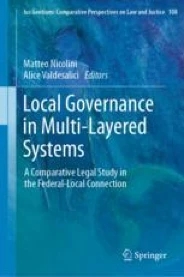A problem of collocation
‘What is the place of local government in federal studies?’ This is the question that we asked ourselves when we decided to venture forth into the local-federal tangle. We knew for certain that local government has its own place within federal arrangements. We assume that this is a predicament to which every federal scholar might wish to subscribe. What this ‘place’ implies, however, is an aspect that still need exploration. Although local government has been integrated into the umbrella of federal studies in more recent years, its investigation within federal settings is still considered as an anomaly in many respects. To put it differently, what this ‘collocation’ implies for federal systems is not as clear as one might expect.
The ‘anomaly’ to which we refer does not stem from scholarly disagreement. Nor does it mean that local government is a neglected area of studies. Quite the opposite. As we have just noted, the federal-local connection is an extremely well chartered territory: there are loads of essays on local bodies, but most of them are elusive as regards local institutions and – above all – their relations within federal systems. References in handbooks are indeed limited, often confined to introductory chapters and comparative conclusions. What is lacking is a more systemic and comparative perspective, combining a constitutional perspective with an empirical observation of practice when assessing local authorities as effective actors of federal dynamics.
Our assumption was – and still is – that federal studies are elusive as regards local authorities owing to a problem of collocation. We are not denying that local government can be easily located within the broader context of federalism, which indeed brings about a huge heterogeneity of local bodies in practice, also affecting the balance and dynamics of federal systems to a great extent.
Local government in a trap?
When starting our research, though, our preliminary comparative survey showed us that, in federal studies, local authorities are ‘federally trapped’ into a kind two-tier dialectic: their collocation, in other words, depends on how federal constitutions assign the jurisdiction over them either to the national or subnational level of government – or to both of them –, thus determining which level of government is responsible for arranging their forms and functions.
Hence, local bodies are formally located in the hands of either the national or subnational level of government. Thisresonates with the scholarly collocation of local authorities in traditional federal studies. In aggregative and emergent federations (such as Canada, the USA, Ethiopia, and Bosnia and Herzegovina), subnational units have exclusive jurisdiction over local bodies; the latter are considered ‘creatures,’ ‘mere political subdivisions,’ and units’ ‘auxiliaries … for the purposes of local government’, ‘creatures of the states’ (U.S. Supreme Court, Atkin v. Kansas, 191 U.S. 207 (1903), at 220). By contrast, devolutionary federations all around the world entrench local bodies in their national constitutions; that constitutional recognition allows the national government to have a say on the allocation of powers at the local level, in most of the cases leading to an intricate concurrency as regards to local forms and functions, often at the expense of the subnational government.
Overlapping and often competing jurisdictions trigger the belief that local government is ‘federally trapped’ in an ‘uncomfortable ménage à trois’ between all levels of government (Steytler, 2007, 229).
On top of that, asymmetric arrangements with federal systems add complexity to the existing constellation of local regimes, as subnational governments may have differentiated powers in relation to local bodies. Finally, prototypes of federalism are mainly Western-related. Suffice it here to remember the Panchayat in India, traditional leaders in South Africa, ‘Indigenous Local Authorities’ in the Australian state of New South Wales. The same occurs in Palau, the Federated States of Micronesia, and Mexico. Likewise, in Pakistan, traditional village governance (the dera) interweaves with local government. Yet, these institutions are considered a hindrance to a comparative analysis, as they are hardly squaring with Western taxonomies, and therefore positioned at the margins of federal studies.
Bearing this in mind, our edited book ‘Local Governance in Multi-Layered Systems: A Comparative Legal Study in the Federal-Local Connection’ attempts to re-position local government within federal studies through the lenses of the comparative legal method. To this end, we asked colleagues around the world to join our research. We assigned each of them a given federal system asking to map its system of local government and devise a country report.
Defining the borders of the analysis
In so doing, we acknowledge that the most contentious issue was (and still is) the definition of ‘federal system’ – a definition which Watts labelled the caput mortuum of our discipline (Watts, 2013, 20). To sidestep this intractable question, we decided to adopt the broadest possible definition, thus extending the scope of the investigation over all systems that, to various degrees, have been examined and classified within our discipline. For our purposes, ‘federation’ encompasses aggregative (the USA, Canada, Switzerland, Germany, Australia, and Austria) and devolutionary (Belgium, Bosnia Herzegovina, Italy, Spain, the UK, Argentina, Brazil, Mexico, and the Russian Federation) federations, as well as the federations beyond the West, where the process of post-colonial reinvention also affects the federal-local connection.
This has entailed not only dismissing the straitjackets of traditional taxonomies of Western federations, but also adopting an overall more nuanced approach to local government. The constellation of local regimes is much more complex than that described under federal taxonomies (Kincaid, 2005, 38; Steytler and Ayele, 2018). To cope with this heterogeneity, the book considers the shortcomings between the black-letter constitution and its operational rules, complementing the case study analysis with an empirical approach. By going beyond the formal recognition of local government, we sidestep the federal trap and shed light on the operational rules of local regimes beyond the traditional two-tier federal dialectic. This also allows us to explore a vast array of constitutional regimes and reappraise the classifications we usually adopt to examine the diversity of local bodies under different federal designs.
Insights on the methodology
In dealing with complexity, the comparative legal method has indeed proven capable of disengaging local government from its marginal collocation within federal studies. This has meant neither reducing nor oversimplifying the existing diversity; it only helps us to go beyond the federal trap in its traditional understanding, by revisiting its foundations and constraints. Relocation therefore entails comparing the assortment of national regimes, detecting existing deviations from the traditional paradigm(s), as well as analogies and differences between them, with the ultimate aim of reconceptualising local government within the federal dynamics.
To pursue this goal, each case study explores the constitutional recognition of local government and the distribution of powers related thereto, including the different forms of concurrency of powers – i.e., the exercise of jurisdiction by national and subnational governments in the same policy areas. The variety of local bodies is also examined, as well as their functions and their systems of finance. Finally, institutions and practices of intergovernmental cooperation between local bodies and the other tiers of government within the different federal system are explored. These areas of investigation are selected for the crucial role they play in shaping intergovernmental relations with and on local government, thus exerting a key role in determining the latter’s place in federal systems and very often giving rise to major deviations from traditional paradigms and mutations of the federal balance and its dynamism.
What to expect from the book
‘Local Governance in Multi-Layered Systems: A Comparative Legal Study in the Federal-Local Connection’ thus aims to challenge the traditional two-tier collocation of local government within federal systems. It does so through a comparative legal analysis, which gives evidence of the strong structural and functional heterogeneity that exists in the practice of federal systems. The choice of reviewing the place of local government in federal systems has indeed demonstrated that these are key elements of federal systems.
In so doing, several interactions among legal and non-legal factors have emerged. These also have a strong impact on the phenomenon under scrutiny and beyond that on the very functioning of federal systems. It is not by chance that these elements precisely call into question the ‘federal trap’ and discard its raison d’être.
The temptation would therefore be to classify the heterogeneity of local governments under different labels, once again running the risk of pointlessly encumbering this area of research. Local government can hardly be traced back to the oversimplification typical of comparative taxonomies; their revisiting, however, does contribute to the (re-)positioning of local government in federal studies.
We may conclude that the topic under scrutiny is still ‘unripe’ to reach (hasty) conclusions; there is still room left for doctrinal interest towards an integrated, and intergovernmental, reading of local governance as a contributing factor to a real understanding of the federal dynamics.
Posted by M. Nicolini (University of Verona, Verona, Italy – e-mail: matteo.nicolini[@]univr.it) and A. Valdesalici (Eurac Research – Institute for Comparative Federalism, Bolzano, Italy e-mail: alice.valdesalici[@]eurac.edu)

